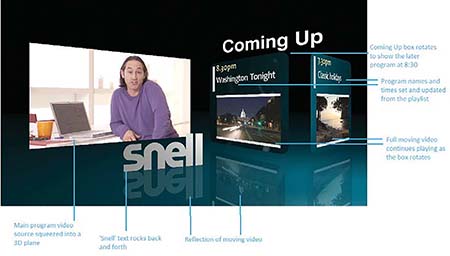Branding: Making Your Channel Stand Out

Snell’s ICE Channel-in-a-Box features advanced graphics capabilities.
OLYMPIA, WASH.—In today’s dynamic media environment, channel branding revisions and customizations come often, requiring agility, design and deployment optimization in both the creative and the broadcast execution phases. And all while watching the bottom line.
Broadcasters “need to offer many different channels, and branding is becoming more important,” said Pete Challinger, vice president of business development for Bannister Lake, a graphics automation vendor based in Cambridge, Ontario. “At the same time, the money for doing all of this is less.”
The availability of IP-based nontraditional channels for mobile and OTT is a major inflection point for the industry.
“If you are a broadcaster, this change brings a shift from a linear to a nonlinear world with respect to how content is viewed,” said James Gilbert, CEO of Pixel Power, a Cambridge, U.K.-based provider of channel branding and broadcast graphics systems. With nontraditional competitors like Amazon and Netflix, broadcasters have to adapt their content for OTT and mobile devices. At the same time, broadcasters have to figure out how to monetize their offerings on these new platforms.
“In order to maintain market advantage, they need strong and consistent branding across all channels that is engaging and entertaining,” Gilbert continued. “If they are unable to maintain this, they risk losing customers.”
AUTOMATING THE PROCESS
Broadcasters are confronted with rising financial pressures and the launch of new channels, making monetization more difficult, given the abundance of free content. Broadcasters must also cope with less clarity of channel definition when compared to what they were used to when they only had to focus on one channel and a branding strategy that closely matched. Instead, branding today must be diversified for SD, HD as well as streaming broadcasts for mobile devices. Because mobile broadcasts require direct control of branding on a streaming server, the challenge comes with trying to control different islands with differentiated brand approaches. Automation can address some of this multitasking, but there are also other challenges that stations face. These include limiting the number of operators they employ when the number of channels they support is growing.
Get the TV Tech Newsletter
The professional video industry's #1 source for news, trends and product and tech information. Sign up below.
“Automated branding is a necessity, given the velocity of change in broadcasting which in turn is affecting the velocity of change in branding and promotions,” said Ian Young, product specialist for Snell Group in Newbury, U.K. “This is why there are many systems in the market for automated promotions today.”
Unfortunately, many of these solutions are extremely monolithic and somewhat rigid,” Young continued. “For example, when the creative director wants to change branding content, he has to go back to the branding solution provider for the change. This places the broadcaster in a ‘pay and wait’ position for changes that end up being expensive and not necessarily timely.”
Competing in an environment of new players that are exploiting nontraditional media, broadcasters must also maintain and continue to build strength in traditional channels. As a result, they seek a combination of agile and responsive branding that can advance their brand across a variety of diverse channels. They also want ways to monetize this effort with advertising revenues, and a means to do it all without increasing operating expenses.
It’s a difficult order to fill, given the natural opposition to added costs and operations. Consequently, in most cases, changing any approach to branding, channel management—and the technologies that facilitate them—must be done in a way that is not entirely disruptive to practices that staff are already familiar with.
“Because of this, many customers come to us looking for flexibility,” said Young. “They tell us that they want branding and master control solutions that can be built from the ground up, but that these must also be able to work with embedded practices and methods that they don’t want to disrupt.” Broadcasters also want these systems to work with existing traffic management systems and graphics devices that they already have in place, and they want the new technology to reduce operating expenses.
Exceptions to maintaining the old with the new are broadcasters that have migrated to a “green field” operation, which often opt for a CIaB (channel in a box) solution with embedded graphics; or broadcasters with existing systems that are nearing end of life and require major changes.
Regardless of a broadcaster’s particular situation, branding and alternate delivery for branding are major pain points for all broadcasters now.
“Broadcasters have historically run traditional sports and news channels,” said Gilbert. “Now they must address new delivery channels like video on demand and mobile devices. The key thing is to find tools that allow you to work in both linear and nonlinear delivery channels that allow you to rapidly repurpose the same content based upon the medium.”

James Gilbert, CEO, Pixel Power A case in point is Scandinavian broadcaster SBS Broadcasting, which was tasked with launching 18 channels in six weeks. With its playout center in London, SBS operates channels that are broadcast throughout Scandinavia, Finland, Hungary, Bulgaria and Romania. In 2011, SBS had to increase regionalization of its Swedish channel from four feeds to 18, but it had to find a way to do so without increasing headcount in master control. It also wanted technology that could integrate with its existing master control.
SBS installed Pixel Power’s Channel- Master integrated playout systems that supported up to 40 channels, with half the channels dedicated to production and the remainder to full redundant backup for failover. It used its existing scheduling system and workflows, which provided the playlists for each region and automated the ingestion of playlists. Serial automation triggered the start of commercial breaks. SBS met its six-week window to launch all 18 channels without increasing headcount.
LIVE VS. CANNED
In live sports, broadcasters need to intercede manually with automation at the master control console because they must tie branding and messaging in with the flow of events based on how those events unfold. For example, you might have a commitment with a sponsor to run three advertising “snipes” during a game, but placement is based upon the flow of the game. You have to manually determine when to inject those snipes—say, at a point in the game when the action is more or less routine, and the viewer is best positioned to receive the snipe. This requirement is less important in highly predictable channels, like movie channels where the flow of content is already identified. New branding automation enables sportscasters to do this.
With the rapid growth in the number of channels, a single operator might have to actively manage 20 channels at once, including the change-outs of text, graphics and monitoring. While he is doing this, the velocity of change is accelerating. In the outside market, the competition for viewers and advertising is also heightening. Every channel in this environment seeks to establish itself by capturing and retaining the attention of impatient viewers, so it must have a constant flow of fresh and exciting content. This includes overhead for managing both content and branding, which now requires automation, agility and the ability to seamlessly blend new and existing technologies.
The workflow automation and greater flexibility of branding solutions enable broadcasters to deliver many extra channels without increasing manpower because there are easier ways to repurpose and provision content.
“Automation also gives broadcasters more time for setting their strategies for monetization—which might include diverse approaches for distributing premium pay-per-view content and standard ‘free’ content,” said Gilbert. “Broadcasters can engage social media channels and also tailor content for mobile devices, based upon what they learn about these markets. For instance, if your viewers consist primarily of people who use iPads, it is possible to obtain a demographic profile of this market segment and to target your promotions to them based upon their lifestyles and needs. This improves revenue capture and excites sponsors.”
